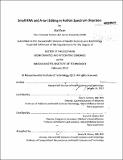| dc.contributor.advisor | Isaac S. Kohane and Louis M. Kunkel. | en_US |
| dc.contributor.author | Eran, Alal | en_US |
| dc.contributor.other | Harvard--MIT Program in Health Sciences and Technology. | en_US |
| dc.date.accessioned | 2013-06-17T19:50:07Z | |
| dc.date.available | 2013-06-17T19:50:07Z | |
| dc.date.copyright | 2013 | en_US |
| dc.date.issued | 2013 | en_US |
| dc.identifier.uri | http://hdl.handle.net/1721.1/79243 | |
| dc.description | Thesis (Ph. D. in Bioinformatics and Integrative Genomics)--Harvard-MIT Program in Health Sciences and Technology, 2013. | en_US |
| dc.description | Cataloged from PDF version of thesis. | en_US |
| dc.description | Includes bibliographical references. | en_US |
| dc.description.abstract | One in every 88 children is diagnosed with Autism Spectrum Disorders (ASDs), a set of neurodevelopmental conditions characterized by social impairments, communication deficits, and repetitive behavior. ASDs have a substantial genetic component, but the specific cause of most cases remains unknown. Understanding gene-environment interactions underlying ASD is essential for improving early diagnosis and identifying critical targets for intervention and prevention. Towards this goal, we surveyed adenosine-to-inosine (A-to-I) RNA editing in autistic brains. A-to-I editing is an epigenetic mechanism that fine-tunes synaptic function in response to environmental stimuli, shown to modulate complex behavior in animals. We used ultradeep sequencing to quantify A-to-I recoding of candidate synaptic genes in postmortem cerebella from individuals with ASD and neurotypical controls. We found unexpectedly wide distributions of human A-to-I editing levels, whose extremes were consistently populated by individuals with ASD. We correlated Ato- I editing with isoform usage, identified clusters of correlated sites, and examined differential editing patterns. Importantly, we found that individuals with ASD commonly use a dysfunctional form of the editing enzyme ADARB1. We next profiled small RNAs thought to regulate A-to-I editing, which originate from one of the most commonly altered loci in ASD, 15q11. Deep targeted sequencing of SNORD115 and SNORD116 transcripts enabled their high-resolution detection in human brains, and revealed a strong gender bias underlying their expression. The consistent 2-fold upregulation of 15q11 small RNAs in male vs. female cerebella could be important in delineating the role of this locus in ASD, a male dominant disorder. Overall, these studies provide an accurate population-level view of small RNA and A-to-I editing in human cerebella, and suggest that A-to-I editing of synaptic genes may be informative for assessing the epigenetic risk for autism. | en_US |
| dc.description.statementofresponsibility | by Alal Eran. | en_US |
| dc.format.extent | 245 p. | en_US |
| dc.language.iso | eng | en_US |
| dc.publisher | Massachusetts Institute of Technology | en_US |
| dc.rights | M.I.T. theses are protected by
copyright. They may be viewed from this source for any purpose, but
reproduction or distribution in any format is prohibited without written
permission. See provided URL for inquiries about permission. | en_US |
| dc.rights.uri | http://dspace.mit.edu/handle/1721.1/7582 | en_US |
| dc.subject | Harvard--MIT Program in Health Sciences and Technology. | en_US |
| dc.title | Small RNA and A-to-I editing in Autism Spectrum Disorders | en_US |
| dc.title.alternative | Small RNA and adenosine-to-inosine editing in Autism Spectrum Disorders | en_US |
| dc.title.alternative | Small ribonucleic acid and A-to-I editing in ASD | en_US |
| dc.type | Thesis | en_US |
| dc.description.degree | Ph.D.in Bioinformatics and Integrative Genomics | en_US |
| dc.contributor.department | Harvard University--MIT Division of Health Sciences and Technology | |
| dc.identifier.oclc | 845363428 | en_US |
